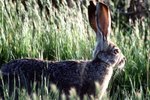
Marmots make up a genus of ground squirrels. Groundhogs and hoary marmots are among the 14 distinct Marmota species. Marmots typically inhabit ranges in cool, mountainous areas including Alaska, Siberia and the Himalayas. Just one species of marmot, the yellow-bellied marmot (Marmota flaviventris), inhabits California -- this species enjoys warmer, drier habitat than its cousins. Yellow-bellied marmots are stocky, robust herbivores sometimes known as whistle pigs due to their shrill vocalizations.
Range and Habitat
The yellow-bellied marmot is native to western North America, making its burrows in meadows or valleys at elevations often above 6,000 feet. Its range includes the northeast corner of California as well as some of southern California, particularly the Sierra Nevada mountains. Outside of California, the species inhabits much of the Cascade and Rocky mountains in the United States and parts of Canada.
Physical Characteristics
With a stocky build and body length between 19 and 26 inches, the yellow-bellied species is at the same time a large marmot and a small or medium-size rodent. The male averages about 8.5 pounds; the female around 6 pounds. The yellow-bellied marmot has a broad head covered in dark fur and a characteristic yellow band across its nose. As the animal’s name suggests, he has lighter, yellowish fur on his underside, contrasting with the darker fur of the rest of its body. The creature's dense fur extends to the tail, which measures 5 to 8 inches.
Diet
Like all marmots, those of the yellow-bellied species are herbivores, meaning their diets consist solely of plant matter. The meadows and slopes they inhabit provide a rich range of grasses and other vegetation on which to forage. Yellow-bellied marmots hibernate in burrows for much of the year -- from fall to spring -- but do not store food for their hibernation period. Marmots in California’s parks, like Sequoia National Park, also attempt to feed on the toxic antifreeze of car engines. Biologist Harold Werner believes this is an attempt to supplement their diets with minerals.
Behavior
Most yellow-bellied marmots live in colonies of multiple individuals and burrows. They are social animals that play, groom and communicate with each other. Some interactions can be territorial or hostile, particularly between males. Both males and females communicate through sight, sound and scent. Their vocalizations include whistles, screams and tooth chatters, all of which communicate alarm or threat in specific ways.
References
- University of Michigan - Museum of Zoology Animal Diversity Web: Marmota Flaviventris
- National Park Service - Rocky Mountain National Park: Marmot
- International Union for Conservation of Nature and Natural Resources - Red List: Marmota Flaviventris
- National Wildlife Federation: Is That a Marmot Under My Hood?
Photo Credits
-
Jupiterimages/Photos.com/Getty Images
Writer Bio
E. Anne Hunter has more than a decade of experience in education, with a focus on visual design and instructional technology. She holds a master's degree in education. Hunter has contributed to several professional publications, covering education, design, music and fitness, among other topics.



